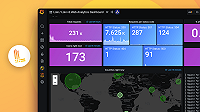This is documentation for the next version of Loki. For the latest stable release, go to the latest version.
Install the simple scalable Helm chart
This Helm Chart deploys Grafana Loki in simple scalable mode within a Kubernetes cluster.
This chart configures Loki to run read, write, and backend targets in a scalable mode. Loki’s simple scalable deployment mode separates execution paths into read, write, and backend targets.
The default Helm chart deploys the following components:
- Read component (3 replicas)
- Write component (3 replicas)
- Backend component (3 replicas)
- Loki Canary (1 DaemonSet)
- Gateway (1 NGINX replica)
- Minio (optional, if
minio.enabled=true) - Index and Chunk cache (1 replica)
Note
We do not recommended running scalable mode with
filesystemstorage. For the purpose of this guide, we will use MinIO as the object storage to provide a complete example.
Prerequisites
- Helm 3 or above. See Installing Helm.
- A running Kubernetes cluster (must have at least 3 nodes).
Deploying the Helm chart for development and testing
The following steps show how to deploy the Loki Helm chart in simple scalable mode using the included MinIO as the storage backend. Our recommendation is to start here for development and testing purposes. Then configure Loki with an object storage provider when moving to production.
Add Grafana’s chart repository to Helm:
helm repo add grafana https://grafana.github.io/helm-chartsUpdate the chart repository:
helm repo updateCreate the configuration file
values.yaml. The example below illustrates how to deploy Loki in test mode using MinIO as storage:loki: schemaConfig: configs: - from: "2024-04-01" store: tsdb object_store: s3 schema: v13 index: prefix: loki_index_ period: 24h ingester: chunk_encoding: snappy querier: # Default is 4, if you have enough memory and CPU you can increase, reduce if OOMing max_concurrent: 4 pattern_ingester: enabled: true limits_config: allow_structured_metadata: true volume_enabled: true deploymentMode: SimpleScalable backend: replicas: 2 read: replicas: 2 write: replicas: 3 # To ensure data durability with replication # Enable minio for storage minio: enabled: true gateway: service: type: LoadBalancerInstall or upgrade the Loki deployment.
- To install:
helm install --values values.yaml loki grafana/loki - To upgrade:
helm upgrade --values values.yaml loki grafana/loki
- To install:
Object Storage Configuration
After testing Loki with MinIO, we recommend configuring Loki with an object storage provider. The following examples shows how to configure Loki with different object storage providers:
Caution
When deploying Loki using S3 Storage DO NOT use the default bucket names;
chunk,rulerandadmin. Choose a unique name for each bucket. For more information see the following security update. This caution does not apply when you are using MinIO. When using MinIO we recommend using the default bucket names.
loki:
schemaConfig:
configs:
- from: "2024-04-01"
store: tsdb
object_store: s3
schema: v13
index:
prefix: loki_index_
period: 24h
storage_config:
aws:
region: <AWS region your bucket is in, for example, `eu-west-2`>
bucketnames: <Your AWS bucket for chunk, for example, `aws-loki-dev-chunk`>
s3forcepathstyle: false
pattern_ingester:
enabled: true
limits_config:
allow_structured_metadata: true
volume_enabled: true
retention_period: 672h # 28 days retention
querier:
max_concurrent: 4
storage:
type: s3
bucketNames:
chunks: <Your AWS bucket for chunk, for example, `aws-loki-dev-chunk`>
ruler: <Your AWS bucket for ruler, for example, `aws-loki-dev-ruler`>
admin: <Your AWS bucket for admin, for example, `aws-loki-dev-admin`>
s3:
# s3 URL can be used to specify the endpoint, access key, secret key, and bucket name this works well for S3 compatible storages or if you are hosting Loki on-premises and want to use S3 as the storage backend. Either use the s3 URL or the individual fields below (AWS endpoint, region, secret).
s3: s3://access_key:secret_access_key@custom_endpoint/bucket_name
# AWS endpoint URL
endpoint: <your-endpoint>
# AWS region where the S3 bucket is located
region: <your-region>
# AWS secret access key
secretAccessKey: <your-secret-access-key>
# AWS access key ID
accessKeyId: <your-access-key-id>
# AWS signature version (e.g., v2 or v4)
signatureVersion: <your-signature-version>
# Forces the path style for S3 (true/false)
s3ForcePathStyle: false
# Allows insecure (HTTP) connections (true/false)
insecure: false
# HTTP configuration settings
http_config: {}
deploymentMode: SimpleScalable
backend:
replicas: 3
read:
replicas: 3
write:
replicas: 3
# Disable minio storage
minio:
enabled: false
loki:
schemaConfig:
configs:
- from: "2024-04-01"
store: tsdb
object_store: azure
schema: v13
index:
prefix: loki_index_
period: 24h
ingester:
chunk_encoding: snappy
tracing:
enabled: true
querier:
max_concurrent: 4
storage:
type: azure
azure:
# Name of the Azure Blob Storage account
accountName: <your-account-name>
# Key associated with the Azure Blob Storage account
accountKey: <your-account-key>
# Comprehensive connection string for Azure Blob Storage account (Can be used to replace endpoint, accountName, and accountKey)
connectionString: <your-connection-string>
# Flag indicating whether to use Azure Managed Identity for authentication
useManagedIdentity: false
# Flag indicating whether to use a federated token for authentication
useFederatedToken: false
# Client ID of the user-assigned managed identity (if applicable)
userAssignedId: <your-user-assigned-id>
# Timeout duration for requests made to the Azure Blob Storage account (in seconds)
requestTimeout: <your-request-timeout>
# Domain suffix of the Azure Blob Storage service endpoint (e.g., core.windows.net)
endpointSuffix: <your-endpoint-suffix>
bucketNames:
chunks: "chunks"
ruler: "ruler"
admin: "admin"
deploymentMode: SimpleScalable
backend:
replicas: 3
read:
replicas: 3
write:
replicas: 3
# Disable minio storage
minio:
enabled: falseTo configure other storage providers, refer to the Helm Chart Reference.
Next Steps
- Configure an agent to send log data to Loki.
- Monitor the Loki deployment using the Meta Monitoring Helm chart



